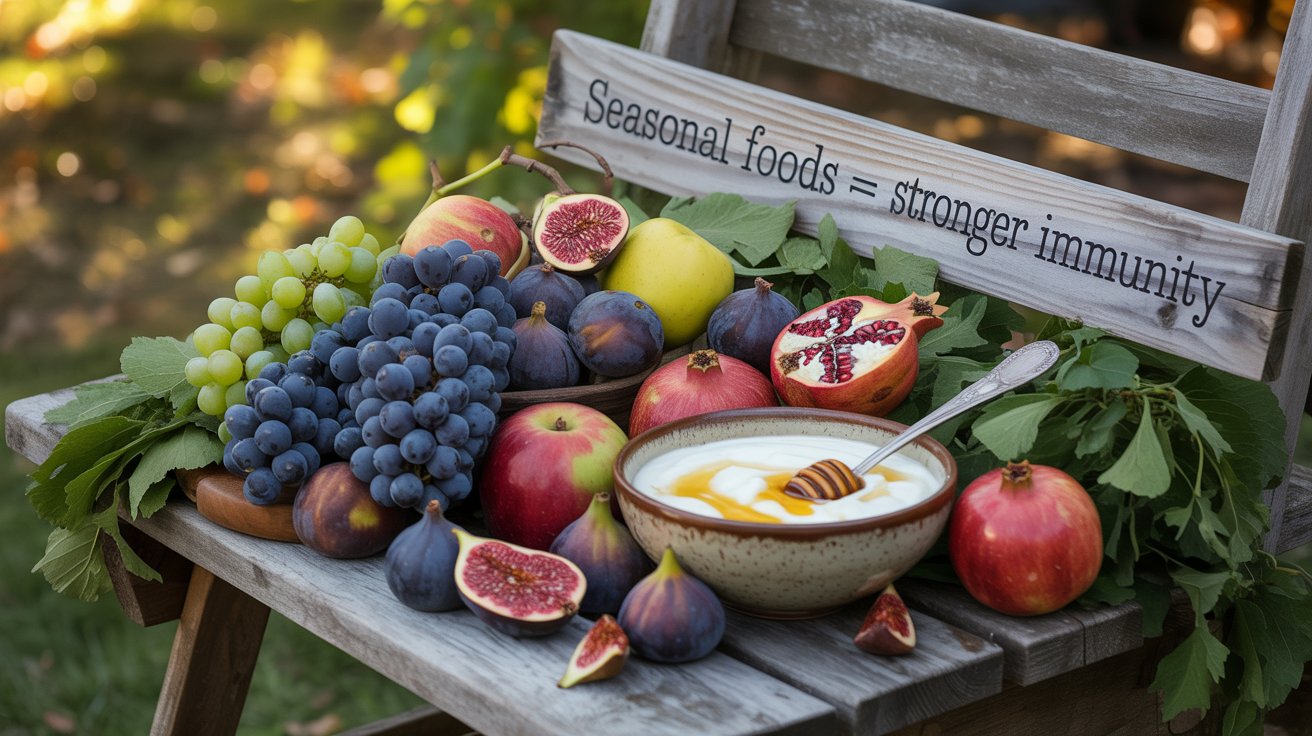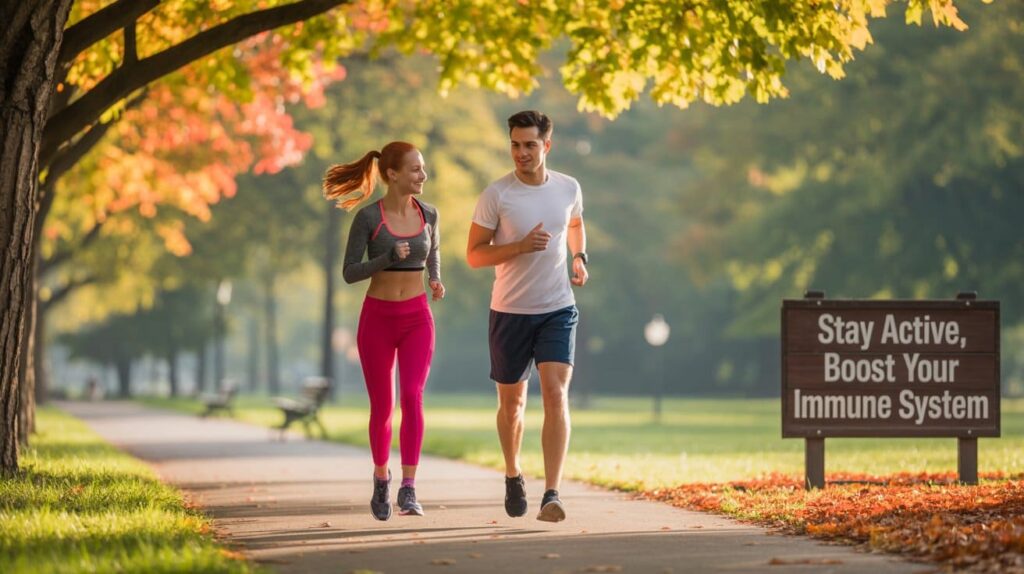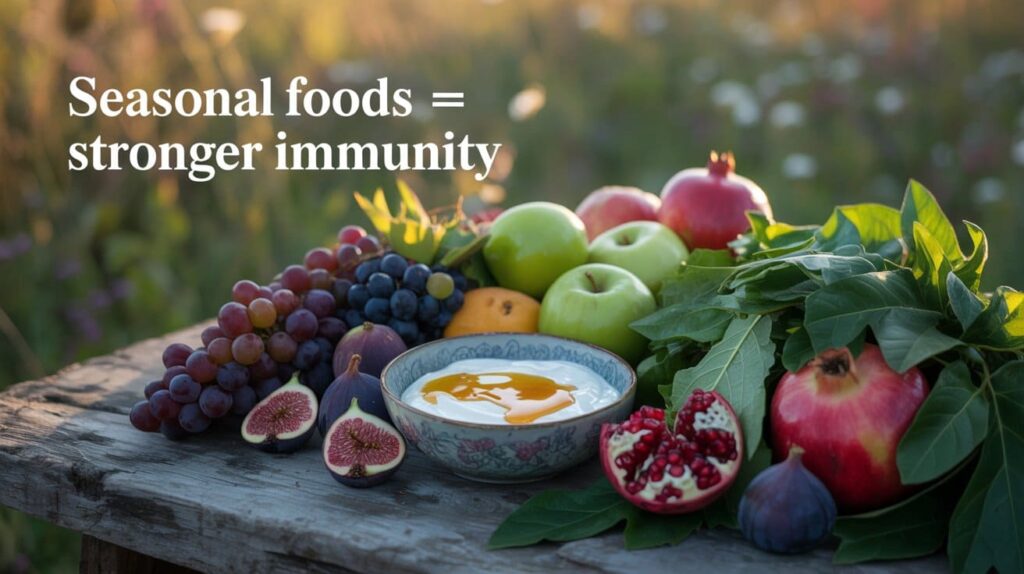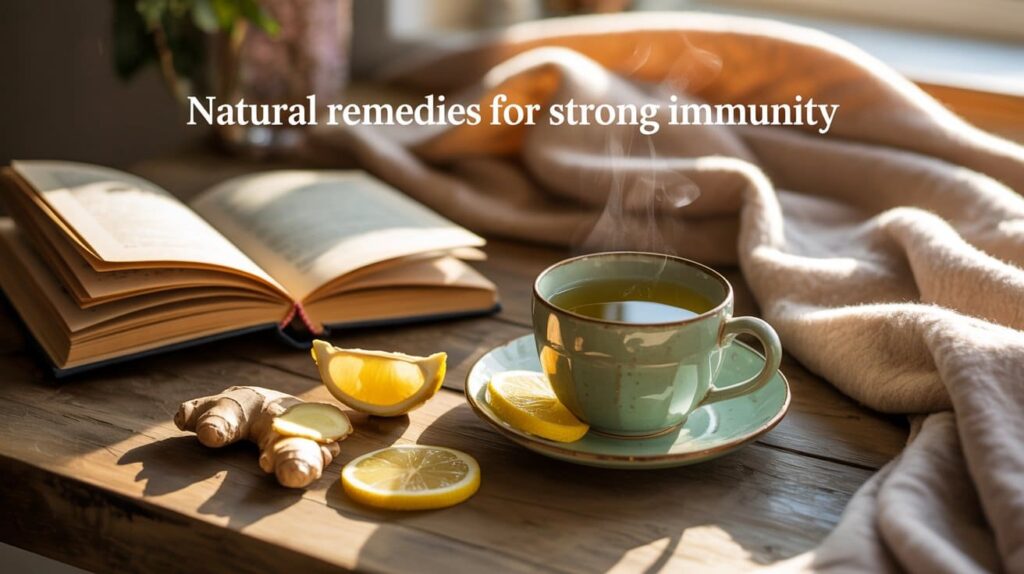
Introduction
As late summer slides into early autumn, many of us notice subtle shifts: shorter days, cooler evenings, back-to-school routines, and a spike in upper respiratory infections. This seasonal transition challenges the immune system in several ways—changes in daylight and circadian rhythms, evolving social patterns, indoor crowding, and shifting dietary choices. The good news: you can strengthen your natural defenses with a science-backed plan that aligns sleep, nutrition, movement, stress care, and hygiene with the realities of August–October.
This guide distills recent medical research from the U.S., Europe, and Asia into practical steps you can start today. You’ll see how fermented foods modulate inflammatory markers, why sleep quality and timing affect vaccine responses, what to know about vitamin D as days shorten, and how moderate exercise and green tea catechins can lower the risk of seasonal infections. We’ll also cover smart flu-shot timing and hand hygiene. Consider this your evidence-based roadmap to arrive in autumn resilient, energized, and well.
Key Points (at a glance)
- Prioritize fermented foods (e.g., yogurt, kefir, kimchi) to support microbiome diversity and reduce inflammatory proteins—effects demonstrated in a randomized diet intervention. CellPubMed
- Protect your sleep: sufficient, regular sleep improves immune regulation and is associated with stronger antibody responses to vaccination; short sleep correlates with weaker vaccine titers. PubMedScience
- Mind the sun gap: vitamin D levels often decline after summer, while supplementation shows mixed evidence for preventing acute respiratory infections—use a test-and-target approach with medical guidance. PubMedPubMed Central
- Move moderately, most days: regular moderate activity is linked to lower cold/URI incidence and better immune surveillance. observatoireprevention.org
- Strategic tea time: randomized trials and meta-analyses from Japan suggest green tea catechins (and, in some studies, theanine) may reduce upper respiratory infections. PubMed CentralSpringerLink
- Get your flu shot on time: in the Northern Hemisphere, aim for September–October, ideally by end of October; coordinate with local guidance. CDCPubMed Central
- Reinforce basics: hand hygiene remains one of the most powerful low-tech immune supports. PubMed
- For background and terminology, see Wikipedia on the immune system and gut microbiota (as general references). Stanford MedicinePubMed Central

The Science of Seasonal Immunity (What changes now?)
Late summer and early autumn bring shorter photoperiods that nudge your circadian clock. Immune cells follow circadian patterns, so disruptions in sleep timing or light exposure can ripple through innate and adaptive immunity. Reviews in Science Immunology and Lancet EBioMedicine highlight how circadian cues shape immune cell trafficking, cytokine rhythms, and inflammatory tone—helpful context for why consistent routines become extra valuable right now. ScienceThe Lancet
Meanwhile, lifestyle patterns change: school and work intensify, more time shifts indoors, and viral exposures climb. Building a protective buffer now—with sleep regularity, nutrient-dense meals, microbiome-supportive foods, and smart movement—helps you meet autumn strong rather than playing catch-up in October.
What to Do: A Late-Summer → Early-Autumn Immunity Plan
1) Make sleep a daily immune intervention
Why it matters: During consolidated night sleep, the immune system coordinates “defense housekeeping” and primes immune memory. Insufficient sleep shortens or disrupts that window, with effects visible in antibody responses after vaccination; recent meta-analysis confirms short sleep is associated with lower post-vaccine antibody titers. PubMed
How to apply it now:
- Target 7–9 hours with consistent bed/wake times (±30–60 minutes), especially on school/work nights.
- Front-load light: get outside within 1–2 hours of waking; dim screens and overheads 60–90 minutes before bed to protect melatonin.
- Time your workout earlier when possible (late-evening, intense sessions can delay sleep).
- If you’re scheduling vaccines this fall, guard the two nights before and after to ensure adequate sleep—small habit, measurable immune payoff. PubMed
For broader physiology, see scholarly reviews on sleep–immune interactions and circadian immunology. Science

2) Feed the microbiome: fermented foods + plants
Why it matters: Your gut microbiota continuously “talks” to immune cells. In a randomized, 17-week diet intervention, a fermented-foods pattern (yogurt, kefir, kimchi, fermented vegetables, kombucha) increased microbiome diversity and reduced 19 inflammatory cytokines (including IL-6) compared with a high-fiber arm over the same period. These are immune-relevant shifts you can create in a few weeks. CellPubMed
How to apply it now:
- Aim for 1–3 servings/day of fermented foods (e.g., ¾ cup plain yogurt or kefir; ¼–½ cup kimchi/sauerkraut; kombucha without added sugar).
- Keep (or add) diverse plant fibers—fruits, vegetables, legumes, whole grains, nuts, seeds—because fermented + fiber is a sustainable combo heading into fall.
- If you’re new to ferments, start low, go slow to minimize bloating while your microbiota adapts.
For definitions/background, see Wikipedia on the immune system and gut microbiota. Stanford MedicinePubMed Central

3) Move moderately (most days)
Why it matters: Consistent moderate-intensity activity supports immune surveillance and is associated with fewer colds/URTIs and faster recovery, without the immune strain sometimes seen after very prolonged, exhaustive efforts. Aim for the WHO minimums (150–300 minutes/week moderate activity + 2 sessions of strength). observatoireprevention.org
How to apply it now:
- 30–45 minutes, 5–6 days/week: brisk walking, cycling, swimming, or light jogging.
- Add 2×/week strength (10–12 sets per session) and mobility on off-days.
- If pollen or cool air triggers you, choose indoor sessions or wear a light scarf early mornings.
4) Use tea catechins as a gentle seasonal edge
Why it matters: Several randomized trials and meta-analyses from Japan (Asia) suggest that green tea catechins—sometimes combined with theanine—can reduce the incidence of upper respiratory tract infections (URTIs) during winter. Late summer is an ideal time to adopt the habit. PubMed CentralSpringerLink
How to apply it now:
- Enjoy 2–4 cups/day of brewed green tea with meals (adjust caffeine to your tolerance).
- If you dislike tea, discuss standardized catechin products with your clinician (quality varies; some studies used specific dosages/forms).
5) Vitamin D: test, then target
Why it matters: At higher latitudes, vitamin D levels tend to fall after summer, and low status is associated with higher respiratory infection risk; however, supplement trials show mixed outcomes for preventing acute respiratory infections. A 2024 meta-analysis in The Lancet Diabetes & Endocrinology reported no significant reduction in ARI risk with vitamin D supplementation overall, underscoring the value of individualized assessment rather than blanket dosing. PubMedPubMed Central
How to apply it now:
- Ask your clinician for a 25(OH)D blood test in late August/September.
- If low or insufficient, agree on a personalized dose and re-test after ~8–12 weeks.
- Combine with dietary sources (oily fish, fortified dairy/plant milks, eggs) and sensible sun exposure where appropriate.
6) Time your flu vaccine and keep hand hygiene tight
Why it matters: Vaccination remains a cornerstone of seasonal respiratory protection. In the Northern Hemisphere, the CDC recommends getting your flu shot by the end of October; ECDC and European national programs issue similar early-autumn guidance. Pair that with robust handwashing to block droplet-to-hand-to-face transmission routes. CDCPubMed CentralPubMed
How to apply it now:
- Book your influenza vaccine for September–October (earlier if your clinic books up quickly).
- Wash hands for ≥20 seconds with soap and water, especially after public transport, before meals, and after coughing/sneezing; carry alcohol hand gel as backup. PubMed

“Figure 1.” Late-Summer Immunity Playbook (What to do & why)
| Habit (Do this now) | What to aim for | Immune-Relevant Mechanism | Key Evidence |
|---|---|---|---|
| Consistent sleep | 7–9 h/night; fixed wake time | Aligns circadian immune rhythms; supports vaccine antibody responses | Meta-analysis links short sleep to reduced post-vaccine antibodies; reviews on circadian immunology. PubMedScience |
| Fermented foods + plants | 1–3 fermented servings/day + diverse fibers | Increases microbiome diversity; reduces inflammatory cytokines | Randomized intervention in healthy adults (Cell, 2021). Cell |
| Moderate exercise | 150–300 min/week + 2× strength | Enhances immune surveillance; lowers URTI risk | Reviews/trials on physical activity & URTIs. observatoireprevention.org |
| Green tea catechins | 2–4 cups/day | Antiviral & immune-modulatory effects; lower URTIs in RCTs | Japanese RCTs & meta-analyses. PubMed CentralSpringerLink |
| Vitamin D (personalized) | Test in late Aug/Sept; treat if low | Corrects deficiency; mixed evidence for ARI prevention | Seasonal decline + 2024 meta-analysis: no overall ARI reduction. PubMedPubMed Central |
| Flu shot timing | Sept–Oct (by end of Oct) | Reduces influenza risk/complications | CDC/ECDC guidance. CDCPubMed Central |
| Hand hygiene | 20-sec wash, frequent | Blocks contact transmission | CDC handwashing evidence. PubMed |

A 7-Day Kickstart (Late-Summer Reset)
Use this one-week plan to lock in habits as September begins.
| Day | Morning | Midday | Evening |
|---|---|---|---|
| Mon | 10-minute outdoor light; oatmeal + berries + yogurt (fermented) | 30-40 min brisk walk; green tea | Salmon + roasted veggies + sauerkraut; lights dim 90 min pre-bed |
| Tue | Scrambled eggs + whole-grain toast; kefir | Mobility + bodyweight strength (20–25 min); green tea | Lentil soup + side salad; warm shower; phone off bedside |
| Wed | Outdoor light; chia parfait (fermented yogurt) | 30-min cycle or swim; mindful breath 5 min | Chicken/tempeh stir-fry with kimchi; bedtime stretch |
| Thu | Whole fruit; nuts; hydration check | Walk meetings; green tea | Baked mackerel + quinoa; handwashing habit check |
| Fri | Kefir smoothie; sun exposure | 35-min jog; refill water | Veggie tacos + fermented salsa; gentle yoga |
| Sat | Late-morning light; omelet + greens | Hike/long walk; green tea social | Curry + cauliflower + raita (fermented); screen-dim early |
| Sun | Plan vaccines/schedule; kefir | 20-min strength circuit; prep fermented sides for week | Early dinner; set Monday alarms; read (no screens) |
Frequently Asked Questions
Q: Can I just take a probiotic instead of eating fermented foods?
A: Probiotics can help some people, but the dietary fermented-foods pattern has shown broad reductions in inflammatory markers and increased diversity in a randomized human trial—a meaningful systems-level effect. Many commercial probiotics contain only a few strains; fermented foods deliver diverse microbes and metabolites alongside nutrients. Cell
Q: I’m cutting caffeine. What about decaf green tea?
A: Most catechin studies used standard green tea; decaf retains catechins, but amounts vary by brand and process. If you’re caffeine-sensitive, try earlier-day standard green tea or consider decaf/standardized catechin products under professional guidance. SpringerLink
Q: Should everyone take vitamin D in fall?
A: Not automatically. The effect on ARI prevention is mixed overall; testing ensures you correct genuine insufficiency without unnecessary dosing. Work with your clinician. PubMed Central
Q: Does exercising in the evening harm immunity?
A: If late workouts disrupt sleep, they can indirectly impair immune function. Prefer earlier sessions when possible; otherwise, keep late workouts light and finish >2–3 hours before bed. Science
Conclusion
You don’t need a radical overhaul to meet autumn with a robust immune system. Prioritize sleep regularity, fermented foods plus plants, moderate movement, and smart tea habits as daily defaults. Layer in personalized vitamin D and schedule your flu shot during September–October, ideally by the end of October. Keep washing those hands. These modest, evidence-based steps compound quickly—so by the time cooler winds arrive, your defenses are already organized, educated, and ready.
If you want, I can tailor this plan to your routine (work hours, preferred foods, training schedule) and convert it into a printable weekly checklist.
References (selected)
- Immune system & gut microbiota (background): Wikipedia overview pages. Stanford MedicinePubMed Central
- Fermented foods & immune markers (U.S./Americas): Wastyk HC et al. Cell randomized diet intervention; plus Stanford summary. CellPubMed
- Sleep & vaccine antibody responses (Europe/US/Asia authors in aggregate): Szmyd B et al., 2023 meta-analysis; reviews on circadian immunology. PubMedScience
- Vitamin D and ARIs (Europe): 2024 meta-analysis—no overall ARI reduction; seasonality of vitamin D status papers. PubMed CentralPubMed
- Physical activity & URTIs: Narrative reviews and trials linking moderate exercise to lower infection risk. observatoireprevention.org
- Green tea catechins (Asia/Japan): RCTs and meta-analyses on URTI/influenza prevention. PubMed CentralSpringerLink
- Flu vaccine timing: CDC (U.S.) and ECDC (Europe) guidance for Northern Hemisphere. CDCPubMed Central
- Hand hygiene: CDC community handwashing evidence. PubMed






